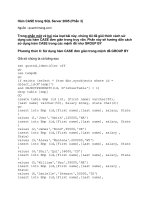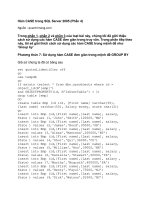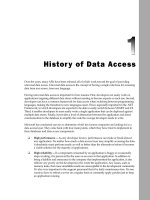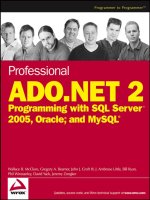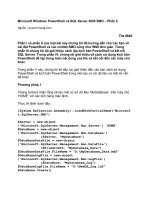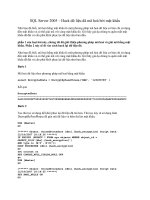Professional SQL Server 2005 XML ppt
Bạn đang xem bản rút gọn của tài liệu. Xem và tải ngay bản đầy đủ của tài liệu tại đây (8.33 MB, 549 trang )
Professional
SQL Server
™
2005 XML
Scott Klein
01_597922 ffirs.qxp 12/3/05 12:24 AM Page i
Professional
SQL Server
™
2005 XML
Scott Klein
01_597922 ffirs.qxp 12/3/05 12:24 AM Page i
Professional SQL Server
™
2005 XML
Published by
Wiley Publishing, Inc.
10475 Crosspoint Boulevard
Indianapolis, IN 46256
www.wiley.com
Copyright © 2006 by Wiley Publishing, Inc., Indianapolis, Indiana
Published simultaneously in Canada
ISBN-13: 978-0-7645-9792-3
ISBN-10: 0-7645-9792-2
Manufactured in the United States of America
10 9 8 7 6 5 4 3 2 1
1MA/SR/RS/QV/IN
Library of Congress Cataloging-in-Publication Data:
Klein, Scott, 1966-
Professional SQL Server 2005 XML / Scott Klein.
p. cm.
Includes index.
ISBN-13: 978-0-7645-9792-3 (paper/website)
ISBN-10: 0-7645-9792-2 (paper/website)
1. SQL server. 2. Client/server computing. 3. XML (Document markup language) I. Title.
QA76.9.C55K545 2005
005.2’768 dc22
2005029721
No part of this publication may be reproduced, stored in a retrieval system or transmitted in any form or by any
means, electronic, mechanical, photocopying, recording, scanning or otherwise, except as permitted under Sections
107 or 108 of the 1976 United States Copyright Act, without either the prior written permission of the Publisher, or
authorization through payment of the appropriate per-copy fee to the Copyright Clearance Center, 222 Rosewood
Drive, Danvers, MA 01923, (978) 750-8400, fax (978) 646-8600. Requests to the Publisher for permission should
be addressed to the Legal Department, Wiley Publishing, Inc., 10475 Crosspoint Blvd., Indianapolis, IN 46256,
(317) 572-3447, fax (317) 572-4355, or online at />LIMIT OF LIABILITY/DISCLAIMER OF WARRANTY: THE PUBLISHER AND THE AUTHOR MAKE NO REP-
RESENTATIONS OR WARRANTIES WITH RESPECT TO THE ACCURACY OR COMPLETENESS OF THE CON-
TENTS OF THIS WORK AND SPECIFICALLY DISCLAIM ALL WARRANTIES, INCLUDING WITHOUT
LIMITATION WARRANTIES OF FITNESS FOR A PARTICULAR PURPOSE. NO WARRANTY MAY BE CREATED
OR EXTENDED BY SALES OR PROMOTIONAL MATERIALS. THE ADVICE AND STRATEGIES CONTAINED
HEREIN MAY NOT BE SUITABLE FOR EVERY SITUATION. THIS WORK IS SOLD WITH THE UNDERSTANDING
THAT THE PUBLISHER IS NOT ENGAGED IN RENDERING LEGAL, ACCOUNTING, OR OTHER PROFES-
SIONAL SERVICES. IF PROFESSIONAL ASSISTANCE IS REQUIRED, THE SERVICES OF A COMPETENT PRO-
FESSIONAL PERSON SHOULD BE SOUGHT. NEITHER THE PUBLISHER NOR THE AUTHOR SHALLBE LIABLE
FOR DAMAGES ARISING HEREFROM. THE FACT THAT AN ORGANIZATION OR WEBSITE IS REFERRED TO
IN THIS WORK AS A CITATION AND/OR A POTENTIAL SOURCE OF FURTHER INFORMATION DOES NOT
MEAN THAT THE AUTHOR OR THE PUBLISHER ENDORSES THE INFORMATION THE ORGANIZATION OR
WEBSITE MAY
PROVIDE OR RECOMMENDATIONS IT MAY MAKE. FURTHER, READERS SHOULD BE
AWARE THAT INTERNET WEBSITES LISTED IN THIS WORK MAY HAVE CHANGED OR DISAPPEARED
BETWEEN WHEN THIS WORK WAS WRITTEN AND WHEN IT IS READ.
For general information on our other products and services please contact our Customer Care Department within
the United States at (800) 762-2974, outside the United States at (317) 572-3993 or fax (317) 572-4002.
Trademarks: Wiley, the Wiley logo, Wrox, the Wrox logo, Programmer to Programmer, and related trade dress are
trademarks or registered trademarks of John Wiley & Sons, Inc. and/or its affiliates, in the United States and other
countries, and may not be used without written permission. All other trademarks are the property of their respective
owners. Wiley Publishing, Inc., is not associated with any product or vendor mentioned in this book.
Wiley also publishes its books in a variety of electronic formats. Some content that appears in print may not be
available in electronic books.
01_597922 ffirs.qxp 12/3/05 12:24 AM Page ii
About the Author
Scott Klein is a software developer and architect, and his passion for SQL Server, .NET, and all things
XML led him to Greenville, South Carolina, where he currently works as a SQL/.NET developer for CSI,
a software solutions company. He has written several articles for TopXML (
www.TopXLM.com) and is a
frequent speaker at SQL Server and .NET user groups around Greenville and the surrounding areas.
When he is not sitting in front of a computer or spending time with his family, he can usually be found
aboard his Yamaha at the local motocross track.
Acknowledgments
Writing a book is a daunting task. Writing your first book is just downright intimidating. The better the
support people you have assisting and guiding you, the easier the task becomes. Therefore, it is only
appropriate to thank those individuals who made this project much easier than it could have been.
First and foremost, Clay Andres for sticking with the book idea when it seemed like the idea wasn’t
going anywhere.
A huge thanks to the folks at Wiley for making this book happen. Brian Herrmann, my awesome devel-
opment editor, was truly that. With my being a first time book author, Brian was a tremendous help and
a sheer delight to work with. Thanks, Brian.
Thanks also to Jim Minatel, for accepting the book idea and letting me write it, and to Derek Comingore,
for technically reviewing this book and providing priceless feedback and help. Thank you, Derek.
I would be remiss if I didn’t mention the following individuals for their assistance in providing informa-
tion. Primarily, I must thank Irwin Dolobowsky, my main contact at Microsoft. Irwin was my go-to guy,
a life saver on many occasions. If he didn’t know the answer, he knew who did or would find out who
did. Also included in the list of Microsoft people to thank are Michael Rys, Arpan Desai, Srik Raghavan,
Mark Fussell, Vineet Rao, and Beysim Sezgin. Thank you, to all of you.
Enough cannot be said about the love and support of my family. For my wife, Lynelle, who held the
house together for the 8+ months I spent upstairs. And to my children, who were patient with their
father knowing that they soon would get their dad back. I love you all.
I can only hope the next book is less daunting.
01_597922 ffirs.qxp 12/3/05 12:24 AM Page iii
Credits
Senior Acquisitions Editor
Jim Minatel
Development Editor
Brian Herrmann
Technical Editor
Derek Comingore
Production Editors
Jonathan Coppola
Tim Tate
Copy Editor
Kathryn Duggan
Editorial Manager
Mary Beth Wakefield
Production Manager
Tim Tate
Vice President and Executive Group Publisher
Richard Swadley
Vice President and Executive Publisher
Joseph B. Wikert
Project Coordinator
Kristie Rees
Graphics and Production Specialists
Carrie A. Foster
Lauren Goddard
Denny Hager
Joyce Haughey
Jennifer Heleine
Alicia B. South
Quality Control Technicians
Laura Albert
John Greenough
Proofreading and Indexing
TECHBOOKS Production Services
01_597922 ffirs.qxp 12/3/05 12:24 AM Page iv
Contents
Introduction xv
Part I: Introduction to SQL Server 2005 XML 1
Chapter 1: What’s New in Version 2.0 of the .NET Framework for XML 3
System.xml Version 2.0 Enhancements and New Features 4
Performance 5
XMLTextWriter and XMLTextReader 5
XMLReader and XMLWriter 5
XSLT Processing 5
XML Schema Validation 6
Type Support 6
XPathDocument 8
XPathNavigator 9
XML Query Architecture 10
XmlReader, XmlReaderSettings, XmlWriter, and XmlWriterSettings 11
Summary 13
Chapter 2: What’s New in SQL Server 2005 XML 15
xml data type 16
xml data type Column 17
xml Variable 17
XML Parameter 18
Function Return 18
Indexes on the xml data type 19
Primary Index 19
Secondary Index 19
XQuery 21
XQuery Structure 21
Additional Concepts 22
XML Data Modification Language 26
Insert 27
Delete 28
Update 28
Transact-SQL Enhancements 29
02_597922 ftoc.qxp 12/3/05 12:23 AM Page v
vi
Contents
FOR XML 29
xml data type Integration 30
Nesting FOR XML Expressions 30
PATH Mode 31
Assigning FOR XML Results 32
HTTP SOAP Access 33
Summary 33
Chapter 3: Installing SQL Server 2005 35
Where to Get SQL Server 2005 Beta 2 Express Edition 35
Installing SQL Server 2005 36
Summary 50
Part II: Server-Side XML Processing in SQL Server 2005 51
Chapter 4: xml data type 53
untyped versus typed XML 54
untyped XML 54
typed XML 56
Making Changes to the xml data type Column 58
Converting from untyped to typed 59
xml data type Methods 59
query() 60
value() 61
exist() 64
nodes() 66
modify 68
Combining Methods 69
Using Operators with Methods 71
Defaults, Constraints, and Computed Columns 73
Defaults 73
Constraints 74
Computed Columns 76
Creating Views 79
XML Settings Options 80
xml data type Best Practices 81
Why and Where 81
typed versus untyped 81
Constraints 82
Limitations 82
Summary 82
02_597922 ftoc.qxp 12/3/05 12:23 AM Page vi
vii
Contents
Chapter 5: Querying and Modifying XML Data in SQL Server 2005 85
XQuery 85
XQuery Structure and Concepts Review 86
XQuery Prolog 89
XQuery Path Expressions 91
XQuery XML Construction 93
FLWOR Statement 95
XQuery Sorting 97
XML Data Modification Language 99
insert 99
delete 105
replace value of 106
Summary 110
Chapter 6: Indexing XML Data in SQL Server 2005 111
Primary XML Index 112
Secondary XML Index 114
PATH 115
VALUE 116
PROPERTY 117
Content Indexing 118
CONTAINS() 120
Altering XML Index 122
Setting Options for XML Indexing 124
Best Practices 124
Ten Commandments of XML Index Creation 125
Summary 125
Chapter 7: XML Schemas in SQL Server 2005 127
Managing XML Schema Collections 128
Creating XML Schema Collections 128
Dropping XML Schema Collections 135
Altering XML Schema Collections 136
Viewing XML Schema Collections 138
XML Schema Collection Permissions 140
Granting Permissions 140
Denying Permissions 142
Revoking Permissions 144
Guidelines and Limitations 146
Summary 146
02_597922 ftoc.qxp 12/3/05 12:23 AM Page vii
viii
Contents
Chapter 8: Transact-SQL Enhancements to FOR XML and OPENXML 147
FOR XML 148
The TYPE Directive 148
RAW Mode Enhancements 151
AUTO Mode Enhancements 153
EXPLICIT Mode Enhancements 155
PATH Mode 157
Nesting FOR XML 162
XSD Schema Generation 165
Things to Watch Out For 166
OPENXML 167
Summary 169
Chapter 9: CLR Support in SQL Server 2005 171
The Great Debate 172
Integration Overview 173
Limitations of T-SQL 174
Introduction to Managed Code 176
Advantages of CLR Integration 180
Choosing Between T-SQL and Managed Code 181
Security 182
Invocation 182
Table-Access 182
Gated 183
CLR Security Integration Goals 183
Summary 183
Part III: Client-Side XML Processing in SQL Server 2005 185
Chapter 10: Client-Side Support for the xml data type 187
SqlXml Class 187
Introducing the CreateReader Method 188
Using the SqlXml Class 188
Updating Data with the SqlXml Class 195
Inserting Data with the SqlXml Class 197
Summary 198
02_597922 ftoc.qxp 12/3/05 12:23 AM Page viii
ix
Contents
Chapter 11: Client-Side XML Processing with SQLXML 4.0 199
SQL Native Client 200
SQL Native Client and MDAC Differences 201
Deployment Considerations 201
xml Data Type Support 201
CreateReader() 202
SQLXML 4.0 Queries with ADO 202
Client-Side Formatting with FOR XML 206
SQLXML Architecture 207
Choosing Between Client-Side and Server-Side XML Formatting 207
FOR XML Modes 208
Summary 210
Chapter 12: Creating and Querying XML Views 211
XML Views and XSD Schemas 211
sql:field 212
sql:relation 213
sql:relationship 214
sql:key-fields 218
Querying XML Views 220
Best Practices 228
Summary 228
Chapter 13: Updating the XML View Using Updategrams 231
Overview and Structure 232
Mapping Schemas and Updategrams 233
Implicit Mapping 233
Explicit Mapping 233
Modifying Data 234
Inserting Data 235
Deleting Data 242
Updating Data 245
Passing Parameters 249
Updategram Concurrency 251
Low-Level Concurrency Protection 251
Medium-Level Concurrency Protection 252
High-Level Concurrency Protection 252
NULL Handling 253
Updategram Security 255
Guidelines and Limitations 255
Summary 255
02_597922 ftoc.qxp 12/3/05 12:23 AM Page ix
x
Contents
Chapter 14: Bulk Loading XML Data Through the XML View 257
Bulk Load Overview 257
XML Data Streaming 258
Bulk Load Operation Modes 258
Bulk Load Object Model 259
Execute Method 259
BulkLoad Property 260
CheckConstraint Property 260
ConnectionCommand Property 260
ConnectionString Property 261
ErrorLogFile Property 261
ForceTableLock Property 261
IgnoreDuplicateKeys Property 262
KeepIdentity Property 262
SchemaGen Property 262
SGDropTables Property 263
SGUseID Property 263
TempFilePath Property 263
Transaction Property 264
XMLFragment Property 264
Bulk Load in a .NET Environment 265
Security Issues 270
Guidelines and Limitations 270
Summary 271
Chapter 15: SQLXML Data Access Methods 273
SQL Native Client 274
SQL Native Client versus MDAC 274
SQLXMLOLEDB Provider 275
SQLXML Managed Classes 289
Web Services 292
Summary 293
Chapter 16: Using XSLT in SQL Server 2005 295
XSLT Overview 296
Nodes 299
Templates 300
XSLT Changes 301
XslCompiledTransform 301
XsltSettings 306
02_597922 ftoc.qxp 12/3/05 12:23 AM Page x
xi
Contents
Moving to the New 307
Guidelines 308
Summary 308
Part IV: SQL Server 2005, SqlXml, and SOAP 309
Chapter 17: Web Service (SOAP) Support in SQL Server 2005 311
SOAP Overview 311
SOAP in SQL Server 2005 312
How Native XML Works 312
Native XML Access Versus SQLXML 314
Native XML Access Benefits 314
Native XML Support Requirements 314
SOAP Configuration 315
Web Methods 315
Endpoints 316
Guidelines and Limitations 329
Best Practices 330
Performance 330
Security 333
Deployment Scenarios 334
Summary 335
Chapter 18: SOAP at the Client 337
Consuming and Using an Endpoint 337
Granting Permissions 339
Building the Client Application 341
Securing an Endpoint 351
Summary 352
Chapter 19: Web Service Description Language (WSDL) 355
WSDL File Overview 356
WSDL File Contents 356
The WSDL Namespace 357
The <types> Element 357
The <message> Element 358
portType 360
Binding 362
Services 363
02_597922 ftoc.qxp 12/3/05 12:23 AM Page xi
xii
Contents
Default WSDL File 364
Mapping SQL Server to XSD Types 364
Mapping SQL Server to CLR Types 365
xml data type 366
Simple WSDL File 366
Custom WSDL File 367
Summary 373
Part V: SQL Server 2005 and Visual Studio 2005 375
Chapter 20: SQL Server 2005 SQLXML Managed Classes 377
SQLXML Managed Classes Object Model 378
SqlXmlCommand Object 378
SqlXmlParameter Object 383
SQLXMLAdapter Object 384
Examples 385
Summary 395
Chapter 21: Working with Assemblies 397
Assemblies 397
Enabling CLR Integration 398
Managed Code 400
Assembly Security 414
SAFE 414
EXTERNAL_ACCESS 414
UNSAFE 414
Summary 415
Chapter 22: Creating .NET Routines 417
Overview 417
Data Access 418
Namespace Requirements 418
SqlContext Object 418
SqlPipe Class 419
SqlDataRecord Class 419
User-Defined Procedures 420
ByRef Output Parameter 420
Returning Results via SqlDataRecord 422
02_597922 ftoc.qxp 12/3/05 12:23 AM Page xii
xiii
Contents
User-Defined Triggers 423
SqlTriggerContext Class 424
INSERT 425
DELETE 428
UPDATE 430
Scalar-Valued UDFs 433
The Easy Way 435
Summary 438
Chapter 23: ADO.NET 441
xml data type 441
Asynchronous Operations 446
Multiple Active Result Sets 449
Query Notifications 451
Summary 453
Chapter 24: ADO.NET 2.0 Guidelines and Best Practices 455
xml data type 455
GetSqlXml 455
ExecuteXmlReader 457
MARS 457
Asynchronous Operations 458
Blocking 458
Error Handling 459
Canceling Commands 459
Query Notification 459
Summary 460
Chapter 25: Case Study — Putting It All Together 461
Existing Application and Infrastructure 462
Current Database Design 462
Current XML Use 463
Partnership Information 463
Current Web Service Use 464
Shortcomings 464
Selecting SQL Server 2005 Features 464
02_597922 ftoc.qxp 12/3/05 12:23 AM Page xiii
xiv
Contents
Integrating Selected Features 465
Utilizing the xml data type 465
Building the HTTP Endpoints 478
SqlXml Managed Classes 480
Building the .NET Routines 483
Summary 484
Appendix A: XQuery in SQL Server 2005 485
Advantages of XQuery 485
Introduction to XQuery 486
What Is XPath? 486
XPath Expressions 486
What Is XQuery? 487
XQuery Expressions 487
The FLWOR Statement 488
XQuery Operators 490
XQuery Functions 495
Using XQuery to Create XML 501
Relational Variables and Columns 503
sql:column() 503
sql:variable() 503
Summary 500
Index 507
02_597922 ftoc.qxp 12/3/05 12:23 AM Page xiv
Introduction
I have a new favorite word, courtesy of a 1961 Robert Heinlein novel titled Stranger in a Strange Land,
and emphasized by Rod Paddock in the March/April 2005 CoDe Magazine article titled “Grokking
.NET.” The word is Grok, and not only is the meaning profound, the word is just fun to say.
In the novel, the word Grok is Martian and means to “understand so thoroughly that the observer becomes
a part of the observed,” but it applies to this book as well because this book is intended to help you Grok
the new XML technologies in SQL Server 2005.
Microsoft is serious about XML and it could not be more evident than with the release of SQL Server
2005, supporting a full-blown new
xml data type. This new data type can be used as a column or in vari-
ables and stored procedures. It also supports technologies such as XQuery and XML Data Manipulation
Language, which provides full query and data modification capabilities on the
xml data type.
The same focus has been taken to support the new
xml data type on the client, and significant changes
and enhancements have been made in version 2.0 of the .NET Framework as well as Visual Studio 2005.
Why put all the work into the backend when you can’t utilize it from the client? For this reason, this the
focus of the book’s energy is on those changes and improvements.
Microsoft also made some significant improvements to SQLXML, and SQL Server 2005 comes with
SQLXML 4.0. The majority of these changes were made to support the new
xml data type, but some
improvements were also made in the security and performance areas to give you a better experience
when dealing with XML.
Whom This Book Is For
This book is for developers with a desire to learn about this new and exciting technology and how it can
be a benefit in their environment. While a previous knowledge of SQL Server 2000, T-SQL, and previous
versions of SQLXML will come in handy, it is certainly not a perquisite to reading this book.
A decent understanding about XML and related technologies (such as XQuery) will also be useful when
reading this book, but it isn’t necessary.
What This Book Covers
This focus of this book is in three primary areas. First and foremost is the new xml data type and server-
side XML processing with associated topics such as indexing and querying of the
xml data type. The
book then turns its focus on the client-side processing of the
xml data type with an emphasis on the new
and enhanced technologies found in SQLXML 4.0. Lastly, the book takes a look at the new enhancements
and changes to the .NET Framework and ADO.NET for the support of the new
xml data type and CLR
integration in SQL Server 2005.
03_597922 flast.qxp 12/3/05 12:20 AM Page xv
xvi
Introduction
How This Book Is Structured
The book is organized into a number of parts and sections to help you better grasp the new technology
coming in SQL Server. The first couple of parts, focusing on SQL Server 2005, lay the foundation for
the rest of the book, which builds on that foundation by discussing how the new version of the .NET
Framework, Visual Studio 2005, and the integration of the CLR can add tremendous benefit to your
environment.
This book is structured as follows.
Part I—Introduction to SQL Server 2005 XML
❑ Chapter 1, “What’s New in Version 2.0 of the .NET Framework for XML,” takes a look at a few
of the new features included in the new version of the .NET Framework as it pertains to XML.
❑ Chapter 2, “What’s New in SQL Server 2005 XML,” provides an overview of the changes and
enhancements between SQL Server 2000 and SQL Server 2005.
❑ Chapter 3, “Installing SQL Server 2005,” provides a quick walkthrough and explanation to
installing SQL Server 2005.
Part II—Server-Side XML Processing in SQL Server 2005
❑ Chapter 4, “xml data type,” introduces the xml data type.
❑ Chapter 5, “Querying and Modifying XML Data in SQL Server 2005,” discusses how to query
and modify the
xml data type.
❑ Chapter 6, “Indexing XML Data in SQL Server 2005,” discusses indexing on the
xml data type.
❑ Chapter 7, “XML Schemas in SQL Server 2005,” discusses XML schemas and XML schema col-
lections.
❑ Chapter 8, “Transact-SQL Enhancements to FOR XML and OPENXML,” talks about the T-SQL
changes and enhancements in SQL Server 2005.
❑ Chapter 9, “CLR Support in SQL Server 2005,” provides an overview of the CLR integration in
SQL Server 2005.
Part III—Client-Side XML Processing in SQL Server 2005
❑ Chapter 10, “Client-Side Support for the xml data type,” discusses the support of the xml data
type from the client with topics such as SQLXML classes.
❑ Chapter 11, “Client-Side XML Processing with SQLXML 4.0,” talks about the changes and
enhancements to SQLXML 4.0 with a focus on the new SQL Native Client.
03_597922 flast.qxp 12/3/05 12:20 AM Page xvi
xvii
Introduction
❑ Chapter 12, “Creating and Querying XML Views,” talks about XML views and XSD schemas.
❑ Chapter 13, “Updating the XML View Using Updategrams,” digs into the changes and improve-
ments to updategrams.
❑ Chapter 14, “Bulk Loading XML Data Through the XML View,” talks about the XML Bulk Load
utility and discusses changes provided by SQLXML 4.0.
❑ Chapter 15, “SQLXML Data Access Methods,” discusses more about the SQL Native Client and
other data access methods such as ADO, OLE DB, and ODBC.
❑ Chapter 16, “Using XSLT in SQL Server 2005,” provides an overview and introduction of XSLT.
Part IV—SQL Server 2005, SqlXml, and SOAP
❑ Chapter 17, “Web Service (SOAP) Support in SQL Server 2005,” introduces and discusses SQL
Server 2005 endpoints (Web Services).
❑ Chapter 18, “SOAP at the Client,” builds on Chapter 18, discussing how to consume and use a
SQL Server 2005 endpoint.
❑ Chapter 19, “Web Service Description Language (WSDL),” introduces and discusses WSDL files,
using the built-in files and what to consider when you want to create your own WSDL file.
Part V—SQL Server 2005 and Visual Studio 2005
❑ Chapter 20, “SQL Server 2005 SQLXML Managed Classes,” introduces SQLXML managed
classes and how to use them from the client with Visual Studio 2005.
❑ Chapter 21, “Working with Assemblies,” introduces assemblies and discusses how to create and
use them in SQL Server 2005 and Visual Studio 2005.
❑ Chapter 22, “Creating .NET Routines,” introduces .NET routines and discusses how to create
and use them in SQL Server 2005 and Visual Studio 2005.
❑ Chapter 23, “ADO.NET,” discusses some of the changes and enhancements to ADO.NET 2.0,
such as asynchronous command operations, query notifications, and support of the
xml data
type.
❑ Chapter 24, “ADO.NET 2.0 Guidelines and Best Practices,” provides some guidelines and best
practices for ADO.NET 2.0.
❑ Chapter 25, “Case Study — Putting It All Together,” provides a case in which most of the tech-
nologies discussed in this book are used.
❑ Appendix A, “XQuery in SQL Server 2005,” provides a brief introduction to the support, syntax,
and usage of XQuery in SQL Server 2005.
03_597922 flast.qxp 12/3/05 12:20 AM Page xvii
xviii
Introduction
What You Need to Use This Book
All of the examples in this book require the following:
❑ SQL Server 2005
❑ Visual Studio 2005
While it is possible to run the products on separate computers, the examples in this book were done with
both products running on the same computer.
Book Conventions
To help you get the most from the text and keep track of what’s happening, we’ve used a number of con-
ventions throughout the book.
Tips, hints, tricks, and asides to the current discussion are offset and placed in italics like this.
As for styles in the text:
❑ We italicize new terms and important words when we introduce them.
❑ We show keyboard strokes like this: Ctrl+A.
❑ We show file names, URLs, and code within the text like so:
persistence.properties.
❑ We present code in two different ways:
In code examples we highlight new and important code with a gray
background.
The gray highlighting is not used for code that’s less important in the present
context, or has been shown before.
Source Code
As you work through the examples in this book, you may choose either to type in all the code manually
or to use the source code files that accompany the book. All of the source code used in this book is avail-
able for download at
. Once at the site, simply locate the book’s title (either by
using the Search box or by using one of the title lists) and click the Download Code link on the book’s
detail page to obtain all the source code for the book.
Because many books have similar titles, you may find it easiest to search by ISBN; for this book, the
ISBN is 0-7645-9792-2.
Boxes like this one hold important, not-to-be forgotten information that is directly
relevant to the surrounding text.
03_597922 flast.qxp 12/3/05 12:20 AM Page xviii
xix
Introduction
Once you download the code, just decompress it with your favorite compression tool. Alternately, you
can go to the main Wrox code download page at
/>.aspx
to see the code available for this book and all other Wrox books.
Errata
We make every effort to ensure that there are no errors in the text or in the code. However, no one is
perfect, and mistakes do occur. If you find an error in one of our books, like a spelling mistake or faulty
piece of code, we would be very grateful for your feedback. By sending in errata you may save another
reader hours of frustration and at the same time you will be helping us provide even higher quality
information.
To find the errata page for this book, go to
and locate the title using the Search
box or one of the title lists. Then, on the book details page, click the Book Errata link. On this page, you
can view all errata that has been submitted for this book and posted by Wrox editors. A complete book
list including links to each book’s errata is also available at
www.wrox.com/misc-pages/booklist
.shtml
.
If you don’t spot “your” error on the Book Errata page, go to
www.wrox.com/contact/techsupport
.shtml
and complete the form there to send us the error you have found. We’ll check the information
and, if appropriate, post a message to the book’s errata page and fix the problem in subsequent editions
of the book.
p2p.wrox.com
For author and peer discussion, join the P2P forums at p2p.wrox.com. The forums are a Web-based
system for you to post messages relating to Wrox books and related technologies and interact with other
readers and technology users. The forums offer a subscription feature to e-mail you topics of interest of
your choosing when new posts are made to the forums. Wrox authors, editors, other industry experts,
and your fellow readers are present on these forums.
At
you will find a number of different forums that will help you not only as you
read this book, but also as you develop your own applications. To join the forums, just follow these steps:
1. Go to p2p.wrox.com and click the Register link.
2. Read the terms of use and click Agree.
3. Complete the required information to join as well as any optional information you wish to pro-
vide and click Submit.
4. You will receive an e-mail with information describing how to verify your account and com-
plete the joining process.
You can read messages in the forums without joining P2P, but in order to post your own messages, you
must join.
03_597922 flast.qxp 12/3/05 12:20 AM Page xix
xx
Introduction
Once you join, you can post new messages and respond to messages other users post. You can read mes-
sages at any time on the Web. If you would like to have new messages from a particular forum e-mailed
to you, click the Subscribe to this Forum icon by the forum name in the forum listing.
For more information about how to use the Wrox P2P, be sure to read the P2P FAQs for answers to questions
about how the forum software works as well as many common questions specific to P2P and Wrox books.
To read the FAQs, click the FAQ link on any P2P page.
03_597922 flast.qxp 12/3/05 12:20 AM Page xx
Part I:
Introduction to SQL
Server 2005 XML
Chapter 1: What’s New in Version 2.0 of the .NET Framework for XML
Chapter 2: What’s New in SQL Server 2005 XML
Chapter 3: Installing SQL Server 2005
04_597922 pt01.qxp 12/3/05 12:20 AM Page 1
04_597922 pt01.qxp 12/3/05 12:20 AM Page 2
What’s New in Version 2.0 of
the .NET Framework for XML
You are probably saying to yourself, “Whoa, wait a minute, I thought this book was about XML
technology in SQL Server 2005.” Yes, that is true. So why start the book off with a chapter about
the XML technology found in version 2.0 of the .NET Framework?
Since the inception of the .NET Framework, Microsoft has taken a serious approach to supporting
XML, a fact proven by looking at the amount of functionality provided in the System.Xml names-
pace, a group of classes specifically designed for the reading, writing, and updating of XML. Even
in the first version of the .NET Framework, the support for XML was tremendous. The list of sup-
ported XML functionality included, but was not limited to, the following:
❑ Integration with ADO.NET
❑ Compliance with W3C standards
❑ Data source querying (XQuery)
❑ XML Schema support
❑ Ease of use
Microsoft set out to create a technology that dealt with data access using XML. Users of
System.Xml in version 1.x of the .NET Framework agree that, on the whole, the technology con-
tained a great number of useful classes that made dealing with XML and its related technologies a
delight.
Even with all of the great advantages with version 1.1, it was not without its shortcomings. First
and foremost, performance was an issue. Because of the way XML is processed, any obstacle or
holdup in processing had a performance effect on the rest of the application. Security was another
issue. For example, in the XML 1.0 specification, no precaution was taken to secure XML, which
led to Denial of Service attacks via DTDs. Not good. The
XmlTextReader had its own problems in
that it could be subclassed and run in semitrusted code.
05_597922 ch01.qxp 12/3/05 12:26 AM Page 3
